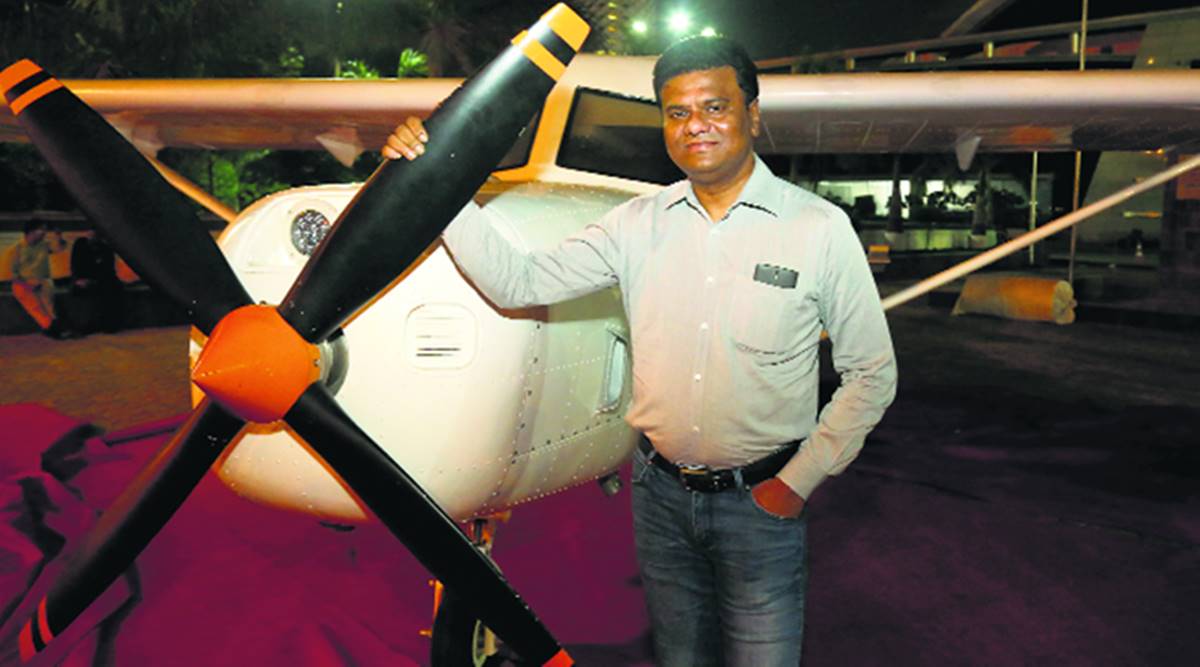Stay updated with the latest - Click here to follow us on Instagram
This Mumbai pilot’s experimental aircraft could take to the skies soon
41-year-old Captain Amol Yadav’s six-seater aircraft receives licence of registration from the DGCA
 Captain Amol Yadav stands next to his six-seater aircraft (Express Photo/Dilip Kagda)
Captain Amol Yadav stands next to his six-seater aircraft (Express Photo/Dilip Kagda)
Seated inside his comfortable duplex home in Kandivali, Shivaji Yadav (71) welcomes each passing visitor with a smile. In the past week, the number of visitors has increased as acquaintances arrive to congratulate the family for getting a certificate of registration for his son Captain Amol Yadav’s indigenous aircraft, claimed to have been built on the terrace of his residence in Sukant Co-operative Housing Society in Charkop.
“We are very happy as we have achieved the impossible. We have achieved the first step of an impossible task that took 17 years to see the light of day. A certificate of registration certifies my son’s hard work. We now await a licence to fly it,” says Shivaji, who runs a construction company. Amol (41), a commander with Jet Airways since 2005, received the licence of registration for the six-seater aircraft, TAC 003, on November 17 from the DGCA.
“The major turn in our lives came when the Civil Aviation Requirement (CAR) Section 2-Series F-Part XVIII, 1992 under the Airworthiness Criteria was deleted from the DGCA website in 2013. The rule allowed for anybody in the country to manufacture an aircraft on an experimental basis. My son made the aircraft under this criteria. While he had applied in 2011, we got no reply. After its deletion, his hard work saw no value,” Shivaji recalls.
In a letter dated December 16, 2015, the DGCA wrote to Amol to pursue a ‘type certification’ for his aircraft from the Aircraft Engineering Department. However, Amol believes his aircraft does not require to be certified for its type as it has been made on an experimental basis.
“When the CAR was deleted, I was shattered. I recall writing multiple letters to the DGCA to understand the reason for its deletion. They replied saying the CAR was deleted as they wanted to regulate the manufacturing of experimental aircraft in the country. Without this CAR, my aircraft did not qualify under any other aviation regulatory standard in the country. It was the darkest moment of my life but my family helped me through this,” Amol recalls.
“The legalities are different for experimental aircraft. Type certification is a process that comes later. Also, amateur-built airplanes need not be built from scratch. You can build them from artificial kits available in a way that qualifies them to fly. Encouragement should be given to build experimental aircraft in the country,” says Captain Vicky Randawa of the Experimental Aircraft Association.
The aircraft, spanning 31 feet in length and weighing 210 kg, has been built at a cost of Rs 5 crore. While Amol is the brain behind it, he credits his father and family for supporting him. Shivaji recalls meeting many political leaders, local MPs and arranging frequent visits to the DGCA office. “We had taken multiple loans to fund the experiment. I did it because I believed in what he was making. He was doing it for a good cause. As he could not be present for many meetings with the regulatory authorities due to his training, I intervened,” he added.
The turning point came when the aircraft was showcased at a ‘Make-In-India’ event in Bandra Kurla Complex in 2016. “After Chief Minister Devendra Fadnavis took notice of our work, he personally took it up with the regulatory authorities. So much so, he even conveyed our issue to Prime Minister Narendra Modi regarding speeding up the process of regulating the CAR,” Amol says.
“The chief minister wanted to push the project because we found it historic. After months of following it up with the DGCA, the new CAR finally came into effect on November 2 this year. This allowed Yadav’s aircraft to get registered,” says Kaustubh Dhavse, officer on special duty to the chief minister.
The new CAR under Section 6 Series A Part III on Aircraft Design and Construction removes the restriction on the model specification of an aircraft. It also allows for the manufacturing of an experimental aircraft in the country. “We had a personal interest in the implementation of the new CAR for experimental aircraft. As we frequently engage in building such aircraft, test our equipment, we wanted that the DGCA comes with its provision soon,” says a senior representative from the NAL, who was also invited for the finalisation of the new CAR draft.
Amol decided to name his aircraft VT-NMD after Modi and Fadnavis for their assistance. “We now await an inspection by the DGCA which can certify the six-seater to fly,” Amol adds. Muneeswaran R, an aeronautical engineer who helped Amol in the feat, says the US has 800 experimental aircraft registered. “It is sad our country fails to see even one. The aircraft made by Captain Amol has qualified the required criteria of flying. The aircraft is as good as any small size aircraft being flown in the country,” he says.
With Thrust Aircraft Private Ltd, his registered company to manufacture aircraft, Amol wants to manufacture more planes for different uses. The family said the Maharashtra Industrial Development Corporation, in a joint venture with Amol’s company, has offered 157 acres in Palghar to be used for the manufacturing of the aircraft. In spite of repeated attempts, DGCA officials remained unavailable to comment.







